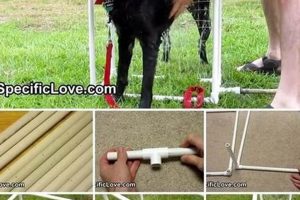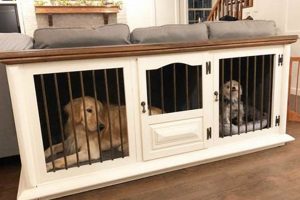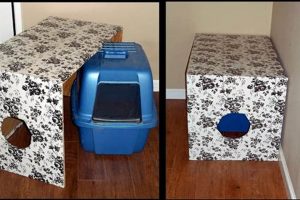Creating personalized identification for canines through do-it-yourself methods allows for unique designs and customized information. These identification markers, often attached to a collar, typically display the animal’s name and owner contact details, facilitating a return should the pet become lost. An example would be stamping metal blanks with the pet’s information using readily available kits.
The significance of readily identifiable pet markers lies in their potential to reunite lost animals with their owners swiftly, minimizing stress for both. This practice offers an economical alternative to professional engraving services. Historically, the need for animal identification has grown alongside urbanization and pet ownership, leading to innovations in materials and techniques for creating these essential accessories.
The subsequent sections will delve into the diverse materials suitable for crafting these personalized items, explore various techniques for imprinting information, and outline essential considerations to ensure durability and legibility for long-term use.
Crafting Durable and Legible Personalized Canine Identification
The following provides guidance on creating lasting and easily readable identification markers for canines, ensuring effectiveness in various environmental conditions.
Tip 1: Material Selection. Opt for durable materials such as stainless steel, brass, or thick aluminum blanks. These materials resist corrosion and physical damage, extending the life of the identification marker.
Tip 2: Information Clarity. Prioritize essential contact information: the animals name and at least one phone number. Limit additional details to maintain legibility, particularly on smaller surfaces.
Tip 3: Imprinting Technique. Use stamping tools specifically designed for metal or consider chemical etching for a permanent and professional finish. Avoid methods that are prone to fading or rubbing off.
Tip 4: Font Size and Style. Choose a clear, easily readable font. A larger font size improves visibility, especially in low-light conditions. Consider block lettering for maximum clarity.
Tip 5: Attachment Method. Secure the identification marker to the collar using a sturdy split ring or clip. Regularly inspect the attachment point for wear and replace as needed to prevent loss.
Tip 6: Protective Coating. Apply a clear, durable coating such as epoxy resin or a polyurethane sealant to protect the imprinted information from abrasion and environmental factors.
Tip 7: Regular Inspection. Periodically check the identification marker for damage, wear, and legibility. Replace the item if it becomes unreadable or compromised.
Adhering to these guidelines ensures the creation of a reliable and long-lasting identification marker, enhancing the likelihood of a safe return should the animal become separated from its owner.
The concluding section will present a summary of the key steps involved and emphasize the importance of maintaining up-to-date contact information.
1. Material durability
Material durability is a paramount consideration in the creation of do-it-yourself canine identification. The identification marker is subject to constant exposure to the elements, friction against the collar and external surfaces, and potential impacts during the animal’s activities. Inferior materials degrade rapidly, leading to illegibility of the inscribed information or complete breakage of the marker. This defeats the purpose of identification, rendering the animal unidentifiable if lost. An example of the importance of durability is evident in coastal environments, where saltwater corrosion can quickly erode softer metals, obliterating crucial contact details.
The selection of robust materials, such as stainless steel or thick gauge brass, mitigates these risks. These materials possess inherent resistance to corrosion, abrasion, and impact, thereby prolonging the lifespan of the identification marker and preserving the integrity of the imprinted information. Furthermore, the thickness of the material is a critical factor. A thicker gauge metal resists bending or breaking under stress, particularly relevant for larger, more active canines. For instance, a thin aluminum marker may easily bend or break if caught on an obstacle, whereas a stainless steel marker of comparable size would likely withstand the impact.
In conclusion, prioritizing material durability is essential for the effectiveness of personalized canine identification. Selecting appropriate materials ensures that the information remains legible and the marker remains intact, even under harsh conditions. This contributes significantly to the likelihood of a successful reunion between a lost animal and its owner. The challenge lies in balancing cost-effectiveness with the necessary level of durability, requiring careful consideration of the animal’s lifestyle and the environmental factors to which the marker will be exposed.
2. Legible imprinting
Legible imprinting is a critical factor determining the efficacy of do-it-yourself canine identification markers. The purpose of such identification is to facilitate the swift return of a lost animal to its owner, a goal rendered unattainable if the inscribed information is unreadable.
- Font Selection and Size
The choice of font directly impacts legibility. Sans-serif fonts, such as Arial or Helvetica, are generally clearer than serif fonts, especially when applied to small surfaces. Font size must be proportionate to the size of the marker, ensuring that all characters are distinct and easily discernible, even under less-than-ideal lighting conditions. For example, cramming too much information into a small space using a small, ornate font renders the identification ineffective.
- Imprinting Method and Depth
The method employed for imprinting influences the durability and legibility of the information. Stamping techniques, if not executed with sufficient pressure, may result in shallow impressions that fade quickly with wear. Conversely, etching methods offer a more permanent solution but require careful execution to avoid blurring or distortion. The depth of the impression is a key factor; it must be deep enough to withstand abrasion but not so deep as to compromise the structural integrity of the marker. Consider the difference between a lightly scratched surface and a deeply engraved one: the former will quickly become unreadable, while the latter will retain its clarity for a longer period.
- Contrast and Background
The contrast between the imprinted information and the background material significantly affects legibility. Dark lettering on a light background, or vice versa, provides optimal contrast. The use of specialized enamel paints or oxidizing agents can enhance the contrast and improve readability, especially for metal markers. For instance, filling stamped impressions with black enamel on a silver metal creates high contrast, making the information easier to read at a glance.
- Information Simplification and Prioritization
Overcrowding the identification marker with excessive information reduces legibility. It is essential to prioritize essential contact details, such as the animal’s name and a primary phone number. Secondary information, such as addresses or alternate contact numbers, should be omitted if space is limited. Simplifying the information ensures that the most crucial details are readily accessible and easily readable by anyone who finds the animal. Imagine trying to decipher a lengthy address in fading script versus instantly spotting a clear phone number.
The combined effect of font choice, imprinting method, contrast, and information prioritization determines the overall legibility of a personalized canine identification marker. A well-executed marker incorporating these considerations significantly increases the likelihood of a safe and timely return for a lost animal. Neglecting any of these aspects compromises the effectiveness of the identification and potentially prolongs the animal’s separation from its owner.
3. Secure attachment
Secure attachment constitutes a critical element in the effectiveness of any do-it-yourself canine identification marker. The primary function of such identification is to ensure the animal’s return to its owner if lost. A marker, regardless of its legibility or informational accuracy, is rendered useless if it detaches from the animal’s collar. The connection between secure attachment and the overall utility of a DIY dog tag is one of direct cause and effect: a failure in the former negates the latter’s purpose. For example, a cheaply made split ring securing a tag to a collar may easily open or break under normal wear and tear, leading to the loss of the identification.
The importance of this secure connection is underscored by the environments in which canines typically operate. Activities such as running through brush, playing with other animals, or simply navigating urban landscapes present numerous opportunities for the identification marker to become snagged or dislodged. Methods of attachment must, therefore, be robust enough to withstand these conditions. Options include the use of heavy-duty split rings, rivets, or direct attachment to the collar via sewn-in loops. Each method offers varying degrees of security and durability, influencing the marker’s longevity. A well-secured tag significantly improves the odds of the animal being identified and returned, reducing stress for both the pet and owner. Examples in practice often show tags dangling loosely from weak connections being rapidly lost, while those firmly affixed remain in place through extended periods of activity.
In summary, secure attachment is not merely an ancillary aspect of creating personalized canine identification; it is a fundamental requirement. The choice of attachment method and the quality of materials used directly impact the marker’s ability to remain affixed to the animal under a range of conditions. Overlooking this crucial detail undermines the investment in crafting a legible and informative marker. The ultimate goal of facilitating the safe return of a lost animal necessitates a holistic approach, where secure attachment is prioritized alongside other key design considerations.
4. Information permanence
The enduring legibility of inscribed details is paramount to the utility of canine identification created through do-it-yourself methods. If the information on a marker fades, erodes, or becomes otherwise illegible, the identification’s purpose is negated. A practical example illustrates this point: a marker crafted from a soft metal and inscribed with easily abraded ink will likely become unreadable within a short period, particularly if the animal is active. The result is an unidentifiable pet, despite the initial effort to provide it with identification. The relationship between permanence and functionality is direct: diminished permanence directly correlates to reduced effectiveness.
Achieving lasting legibility necessitates a multifaceted approach encompassing material selection, inscription method, and protective measures. Choosing robust materials like stainless steel or deeply etching details offer resilience against environmental wear. Applying a protective sealant further safeguards the inscription from abrasion, moisture, and ultraviolet radiation. The practical application of this understanding leads to the informed selection of appropriate tools and techniques. For example, opting for a chemical etching process over simple stamping ensures a deeper, more resilient inscription. Similarly, sealing the finished marker with a durable epoxy resin protects the details from fading, preserving the information’s integrity.
In summary, information permanence is not merely a desirable attribute of personalized canine identification; it is an essential component. Addressing this element requires careful consideration of materials, techniques, and environmental factors. The ultimate goal of ensuring a pet’s safe return hinges on the ability to maintain clear, readable contact information over time. Challenges exist in balancing cost-effectiveness with long-term durability, requiring a pragmatic approach that prioritizes the animal’s safety and well-being.
5. Customized design
The integration of customized design within the do-it-yourself canine identification sphere allows for both enhanced aesthetic appeal and functional adaptation to specific needs. While core identification elements such as contact information remain standardized, the visual presentation offers an opportunity to create a unique item reflecting the animal’s personality or the owner’s preferences. This personalization can range from selecting distinct shapes and colors to incorporating symbolic imagery or patterns. A practical example of customized design’s effect is the creation of an identification marker shaped like a bone for a playful dog or using reflective materials for enhanced visibility during nighttime walks. The customized design does not merely add visual interest; it can increase the likelihood of the item being readily noticed and examined if the animal is lost, potentially leading to a faster reunion.
Customization also extends to functional considerations. Owners may choose to incorporate elements specific to their animal’s medical needs, such as allergy alerts or indications of a microchip implant. For example, a dog with a heart condition might have an identification marker including a brief mention of this, prompting immediate attention if the animal is found in distress. Furthermore, customized design offers the opportunity to tailor the size and weight of the identification marker to suit the animal. Smaller, lighter markers are more appropriate for smaller breeds to avoid discomfort or irritation, while larger, more robust markers may be suitable for larger, more active dogs. An overly large or heavy marker can be as detrimental as a completely absent one. The effect of carefully considered customization, therefore, goes beyond aesthetics and directly impacts the animal’s comfort and safety.
In summary, customized design enhances the do-it-yourself canine identification process by adding aesthetic value and allowing for functional adaptation. While maintaining the essential purpose of identification, customization ensures a unique and practical item tailored to the individual animal’s needs and the owner’s preferences. Challenges exist in balancing aesthetic considerations with functional requirements, ensuring that the design does not compromise the clarity or durability of the essential information. The understanding of this balance is essential for responsible and effective customization.
Frequently Asked Questions Regarding Do-It-Yourself Canine Identification Markers
The subsequent section addresses commonly raised inquiries concerning the creation and application of personalized identification markers for canines.
Question 1: What materials offer the highest durability for canine identification markers?
Stainless steel and thick-gauge brass provide superior resistance to corrosion and physical wear, extending the lifespan of the identification marker. Aluminum, while lighter, is more susceptible to damage and should be of sufficient thickness to maintain integrity.
Question 2: What constitutes the most legible imprinting method for permanent identification?
Chemical etching and deep stamping with durable inks ensure lasting legibility, resisting fading or abrasion from environmental exposure. Surface engraving, if not sufficiently deep, may erode over time.
Question 3: How can secure attachment of the marker to the collar be guaranteed?
Heavy-duty split rings or direct attachment methods employing rivets or sewn loops offer enhanced security against detachment. Regular inspection of the attachment point is recommended to identify and address wear.
Question 4: What information should be included on the identification marker, and in what priority?
The animal’s name and at least one current phone number are essential. Additional information, such as an address or microchip details, should be included only if space permits without compromising legibility.
Question 5: How can the imprinted information be protected from environmental damage?
Application of a clear, durable coating, such as epoxy resin or polyurethane sealant, shields the inscribed details from abrasion, moisture, and ultraviolet radiation, extending the lifespan of the information.
Question 6: How frequently should a do-it-yourself canine identification marker be inspected and potentially replaced?
Regular inspection should occur monthly, with replacement warranted if the marker exhibits significant wear, illegibility, or compromised attachment. Consistent upkeep ensures continued effectiveness.
The creation of reliable identification requires a proactive approach, encompassing diligent material selection, secure attachment, and ongoing maintenance.
The following section will provide expert advice for creating effective identification.
Conclusion
The creation of a diy dog tag necessitates a meticulous approach, prioritizing durability, legibility, and secure attachment above aesthetic considerations. The information conveyed upon the marker serves as a critical link between a lost animal and its owner, rendering the quality of its construction paramount. Compromises in material selection, imprinting techniques, or attachment methods directly impact the likelihood of a successful reunion.
The commitment to crafting a robust and informative identification marker reflects a dedication to the well-being of the animal. Sustained vigilance in maintaining the marker’s integrity, including regular inspection and timely replacement when necessary, is essential. The responsible application of do-it-yourself techniques ultimately contributes to the safety and security of canine companions.







